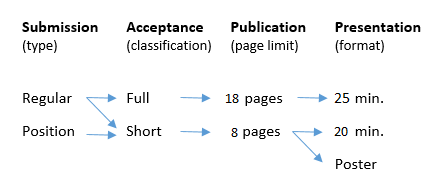Submission Guidelines
Authors can submit their work in the form of a complete paper.
Complete papers can be submitted as a Regular Paper, representing completed and validated research, or as a Position Paper, portraying a short report of work in progress or an arguable opinion about an issue discussing ideas, facts, situations, methods, procedures or results of scientific research focused on one of the conference topic areas.
Authors should submit a paper in English, carefully checked for correct grammar and spelling, addressing one or several of the conference areas or topics. Each paper should clearly indicate the nature of its technical/scientific contribution, and the problems, domains or environments to which it is applicable.
The use of artificial intelligence (AI)–generated text in an article should be disclosed in the acknowledgements section of any paper submitted to this conference. The sections of the paper that use AI-generated text should include a citation to the AI system used to generate the text.
When submitting a complete paper please note that only original papers should be submitted. Authors are advised to read
INSTICC's ethical norms regarding plagiarism and self-plagiarism thoroughly before submitting and must make sure that their submissions do not substantially overlap work which has been published elsewhere or simultaneously submitted to a journal or another conference with proceedings. Papers that contain any form of plagiarism will be rejected without reviews.
All papers must be submitted through the online submission platform
PRIMORIS and should follow the instructions and templates that can be found under
Guidelines and Templates. After the paper submission has been successfully completed, authors will receive an automatic confirmation e-mail.
Reviewing Process
Complete Papers
All regular papers are reviewed by at least two reviewers, but usually by three or more, and rated considering their: Relevance, Originality, Technical Quality, Significance and Presentation;
The reviewers are also asked to answer a group of questions that may help the authors to improve the paper, should it be accepted, namely: Abstract and Introduction are adequate?, Needs more experimental results?, Needs comparative evaluation?, Improve critical discussion?, Figures are Adequate?, Conclusions/Future Work are convincing?, References are up-to-date and appropriate?, Paper formatting needs adjustment?, Improve English?
Finally, the reviewers can provide some free text observations which was given to the authors and also some free text private observations, made available only to the program chair. Conflicting reviews may require assignment of a new reviewer. In the end the program chairs decide. The author has a period for rebuttal, which triggers a workflow involving the chairs and the reviewers if necessary. All rebuttals are answered but decisions are final.
Position papers follow a similar process but the criteria used for classification are slightly different in order to account for the nature of these papers, i.e. speculative ideas and/or ongoing work not yet fully validated.
Conference Paper Formats, including Special Sessions and Workshops
Regular Papers
Submission:
Regular Papers should be submitted, as pdf files with 10,000 to 32,500 characters (excluding white spaces), including references, tables, graphs and appendices. Submissions with less than 10,000 characters or more than 32,500 characters, may not be sent for review.
Acceptance: After, qualifying Regular Papers may be accepted as either Full Papers or Short Papers.
Presentation: Regular Papers classified as Full Papers are awarded a 25’ minutes slot for an oral presentation at the conference. Regular Papers classified as Short Papers are given either a 20’ minutes slot for an oral presentation or assigned to present at a Poster Session. Authors who have been assigned an oral presentation, either Full or Short, may however also choose to present at a Poster Session instead, should they prefer it.
Publication:
Regular Papers accepted as Full Papers will be assigned a 18-page limit in the Conference Proceedings, while Regular Papers accepted as Short Papers have a 8-page limit. The total number of pages to consider is the number obtained after the paper has been correctly formatted according to the appropriate template, including references, tables, graphs and appendices. The Conference Proceedings will be published by Springer, under an ISBN, and will include final versions of all accepted papers, adjusted to satisfy reviewers’ recommendations. They will be made available for online consultation at Springer Link.
Indexation:
The proceedings will be abstracted/indexed in DBLP, Google Scholar, EI-Compendex, INSPEC, Japanese Science and Technology Agency (JST), Norwegian Register for Scientific Journals and Series, Mathematical Reviews, SCImago, Scopus and zbMATH. CCIS volumes are also submitted for the inclusion in ISI Proceedings. More information can be found
here.
Position Papers
Submission:
Position Papers should be submitted, as pdf files with 8,000 to 14,500 characters (excluding white spaces), including references, tables, graphs and appendices. Submissions with less than 8,000 characters or more than 14,500 characters, may not be sent for review.
Acceptance: After peer review, qualifying Position Papers will be accepted as Short Papers.
Presentation: Position Papers are given either a 20’ minutes slot for an oral presentation or assigned to present at a Poster Session. Authors who have been assigned an oral presentation may however also choose to present at a Poster Session instead, should they prefer it.
Publication:
Position Papers will be assigned a 8-page limit in the Conference Proceedings. The total number of pages to consider is the number obtained after the paper has been correctly formatted according to the appropriate template, including references, tables, graphs and appendices. The Conference Proceedings will be published by Springer, under an ISBN, and will include final versions of all accepted papers, adjusted to satisfy reviewers’ recommendations. They will be made available for online consultation at Springer Link.
Indexation:
The proceedings will be abstracted/indexed in DBLP, Google Scholar, EI-Compendex, INSPEC, Japanese Science and Technology Agency (JST), Norwegian Register for Scientific Journals and Series, Mathematical Reviews, SCImago, Scopus and zbMATH. CCIS volumes are also submitted for the inclusion in ISI Proceedings. More information can be found
here.
Schematic Summary
